 |
| 1 |  | 
A charged particle moves through a region of space at constant velocity. Ignore gravity. In the region, is it possible that there is (a) a magnetic field but no electric field? (b) an electric field but no magnetic field? (c) a magnetic field and an electric field? For each possibility, what must be true about the direction(s) of the field(s)? |
|  | |
|
|
 |
| 2 |  | 
A uniform magnetic field directed upward exists in some region of space. In what direction(s) could an electron be moving if its trajectory is (a) a straight line? (b) a circle? Assume that the electron is subject only to magnetic forces. |
|  | |
|
|
 |
| 3 |  | 
Two ions with the same velocity and mass but different charges enter the magnetic field of a mass spectrometer. One is singly charged (q = +e) and the other is doubly charged (q = +2e). Is the radius of their circular paths the same? If not, which is larger? By what factor? |
|  | |
|
|
 |
| 4 |  | 
A horizontal wire that runs east-west carries a steady current to the east. A C-shaped magnet (see Fig. 19.3a) is placed so that the wire runs between the poles, with the north pole above the wire and the south pole below. What is the direction of the magnetic force on the wire between the poles?
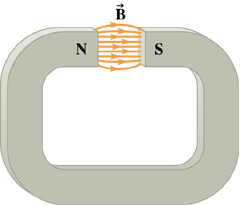 <a onClick="window.open('/olcweb/cgi/pluginpop.cgi?it=gif::Fig. 19.3a::/sites/dl/free/0070524076/58002/19_003a.gif','popWin', 'width=NaN,height=NaN,resizable,scrollbars');" href="#"><img valign="absmiddle" height="16" width="16" border="0" src="/olcweb/styles/shared/linkicons/image.gif">Fig. 19.3a (8.0K)</a>Fig. 19.3a <a onClick="window.open('/olcweb/cgi/pluginpop.cgi?it=gif::Fig. 19.3a::/sites/dl/free/0070524076/58002/19_003a.gif','popWin', 'width=NaN,height=NaN,resizable,scrollbars');" href="#"><img valign="absmiddle" height="16" width="16" border="0" src="/olcweb/styles/shared/linkicons/image.gif">Fig. 19.3a (8.0K)</a>Fig. 19.3a |
|  | |
|
|
 |
| 5 |  | 
Find the magnetic force exerted on an electron moving vertically upward at a speed of 2.0 × 107 m/s by a horizontal magnetic field of 0.50 T directed north. |
|  | |
|
|
 |
| 6 |  | 
Find the magnetic force (magnitude and direction) on an electron moving at speed 8.0 × 105 m/s for each of the directions shown in Fig. 19.52. The magnetic field has magnitude B = 0.40 T.
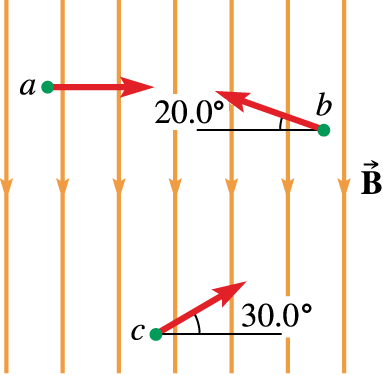 <a onClick="window.open('/olcweb/cgi/pluginpop.cgi?it=gif::Fig. 19.52::/sites/dl/free/0070524076/58002/19_052.gif','popWin', 'width=NaN,height=NaN,resizable,scrollbars');" href="#"><img valign="absmiddle" height="16" width="16" border="0" src="/olcweb/styles/shared/linkicons/image.gif">Fig. 19.52 (10.0K)</a>Fig. 19.52 <a onClick="window.open('/olcweb/cgi/pluginpop.cgi?it=gif::Fig. 19.52::/sites/dl/free/0070524076/58002/19_052.gif','popWin', 'width=NaN,height=NaN,resizable,scrollbars');" href="#"><img valign="absmiddle" height="16" width="16" border="0" src="/olcweb/styles/shared/linkicons/image.gif">Fig. 19.52 (10.0K)</a>Fig. 19.52 |
|  | |
|
|
 |
| 7 |  | 
When two particles travel through a region of uniform magnetic field pointing out of the plane of the paper, they follow the trajectories shown in Fig. 19.54. What are the signs of the charges of each particle?
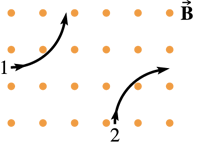 <a onClick="window.open('/olcweb/cgi/pluginpop.cgi?it=gif::Fig. 19.54::/sites/dl/free/0070524076/58002/19_054.gif','popWin', 'width=NaN,height=NaN,resizable,scrollbars');" href="#"><img valign="absmiddle" height="16" width="16" border="0" src="/olcweb/styles/shared/linkicons/image.gif">Fig. 19.54 (3.0K)</a>Fig. 19.54 <a onClick="window.open('/olcweb/cgi/pluginpop.cgi?it=gif::Fig. 19.54::/sites/dl/free/0070524076/58002/19_054.gif','popWin', 'width=NaN,height=NaN,resizable,scrollbars');" href="#"><img valign="absmiddle" height="16" width="16" border="0" src="/olcweb/styles/shared/linkicons/image.gif">Fig. 19.54 (3.0K)</a>Fig. 19.54 |
|  | |
|
|
 |
| 8 |  | 
Crossed electric and magnetic fields are established over a certain region. The magnetic field is 0.50 T vertically downward. The electric field is 2.0 × 106 V/m horizontally east. An electron, traveling horizontally northward, experiences zero resultant force from these fields and so continues in a straight line. What is the electron's speed? |
|  | |
|
|
 |
| 9 |  | 
Repeat Problem 39 if the magnetic field is 2.5 T to the left (in the -x-direction). |
|  | |
|
|
 |
| 10 |  | 
A certain fixed length L of wire carries a current I. (a) Show that if the wire is formed into a square coil, then the maximum torque in a given magnetic field B is developed when the coil has just one turn. (b) Show that the magnitude of this torque is τ = 1/16 L2IB. |
|  | |
|
|
 |
| 11 |  | 
The torque on a loop of wire (a magnetic dipole) in a uniform magnetic field is τ = NIAB sin θ, where θ is the angle between B and a line perpendicular to the loop of wire. Suppose an electric dipole, consisting of two charges ±q a fixed distance d apart is in a uniform electric field E. (a) Show that the net electric force on the dipole is zero. (b) Let θ be the angle between E and a line running from the negative to the positive charge. Show that the torque on the electric dipole is τ = qdE sin θ for all angles -180° ≤ θ ≤ 180°. (Thus, for both electric and magnetic dipoles, the torque is the product of the dipole moment times the field strength times sin θ. The quantity qd is the electric dipole moment; the quantity NIA is the magnetic dipole moment.) |
|  | |
|
|
 |
| 12 |  | 
Two conducting wires perpendicular to the page are shown in cross section as gray dots in Fig. 19.62. They each carry 10.0 A out of the page. What is the magnetic field at point P?
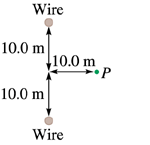 <a onClick="window.open('/olcweb/cgi/pluginpop.cgi?it=gif::Fig. 19.62::/sites/dl/free/0070524076/58002/19_062.gif','popWin', 'width=NaN,height=NaN,resizable,scrollbars');" href="#"><img valign="absmiddle" height="16" width="16" border="0" src="/olcweb/styles/shared/linkicons/image.gif">Fig. 19.62 (3.0K)</a>Fig. 19.62 <a onClick="window.open('/olcweb/cgi/pluginpop.cgi?it=gif::Fig. 19.62::/sites/dl/free/0070524076/58002/19_062.gif','popWin', 'width=NaN,height=NaN,resizable,scrollbars');" href="#"><img valign="absmiddle" height="16" width="16" border="0" src="/olcweb/styles/shared/linkicons/image.gif">Fig. 19.62 (3.0K)</a>Fig. 19.62 |
|  | |
|
|
 |
| 13 |  | 
The intrinsic magnetic dipole moment of the electron has magnitude 9.3 × 10-24 A·m2. In other words, the electron acts as though it were a tiny current loop with NIA = 9.3 × 10-24 A·m2. What is the maximum torque on an electron due to its intrinsic dipole moment in a 1.0-T magnetic field? |
|  | |
|
|
 |
| 14 |  | 
A compass is placed directly on top of a wire (Fig. 19.72, needle not shown). The current in the wire flows to the right. Which way does the north end of the needle point? Explain. (Neglect the Earth's magnetic field.)
 <a onClick="window.open('/olcweb/cgi/pluginpop.cgi?it=gif::Fig. 19.72::/sites/dl/free/0070524076/58002/19_072.gif','popWin', 'width=NaN,height=NaN,resizable,scrollbars');" href="#"><img valign="absmiddle" height="16" width="16" border="0" src="/olcweb/styles/shared/linkicons/image.gif">Fig. 19.72 (4.0K)</a>Fig. 19.72 <a onClick="window.open('/olcweb/cgi/pluginpop.cgi?it=gif::Fig. 19.72::/sites/dl/free/0070524076/58002/19_072.gif','popWin', 'width=NaN,height=NaN,resizable,scrollbars');" href="#"><img valign="absmiddle" height="16" width="16" border="0" src="/olcweb/styles/shared/linkicons/image.gif">Fig. 19.72 (4.0K)</a>Fig. 19.72 |
|  | |
|
|
 |
| 15 |  | 
(a) A proton moves with uniform circular motion in a magnetic field of magnitude 0.80 T. At what frequency f does it circulate? (b) Repeat for an electron. |
|  | |
|
|
 |
| 16 |  | 
An electromagnetic flowmeter is to be used to measure blood velocity. A magnetic field of 0.115 T is applied across an artery of inner diameter 3.80 mm. The Hall voltage is measured to be 88.0 μV. What is the average velocity of the blood flowing in the artery? |
|  | |
|
|
 |
| 17 |  | 
A bar magnet is held near the electron beam in an oscilloscope (Fig. 19.80). The beam passes directly below the south pole of the magnet. In what direction will the beam move on the screen? (Don't try this with a color TV tube. There is a metal mask just behind the screen that separates the pixels for red, green, and blue. If you succeed in magnetizing the mask, the picture will be permanently distorted.)
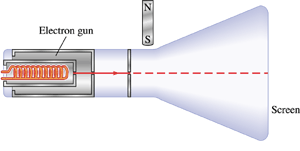 <a onClick="window.open('/olcweb/cgi/pluginpop.cgi?it=gif::Fig. 19.80::/sites/dl/free/0070524076/58002/19_080.gif','popWin', 'width=NaN,height=NaN,resizable,scrollbars');" href="#"><img valign="absmiddle" height="16" width="16" border="0" src="/olcweb/styles/shared/linkicons/image.gif">Fig. 19.80 (11.0K)</a>Fig. 19.80 <a onClick="window.open('/olcweb/cgi/pluginpop.cgi?it=gif::Fig. 19.80::/sites/dl/free/0070524076/58002/19_080.gif','popWin', 'width=NaN,height=NaN,resizable,scrollbars');" href="#"><img valign="absmiddle" height="16" width="16" border="0" src="/olcweb/styles/shared/linkicons/image.gif">Fig. 19.80 (11.0K)</a>Fig. 19.80 |
|  | |
|
|

